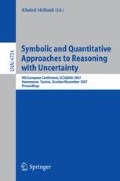Abstract
The binary representation is widely used for representing focal sets of Dempster-Shafer belief functions because it allows to compute efficiently all relevant operations. However, as its space requirement grows exponentially with the number of variables involved, computations may become prohibitive or even impossible for belief functions with larger domains. This paper proposes shared ordered binary decision diagrams for representing focal sets. This not only allows to compute efficiently all relevant operations, but also turns out to be a compact representation of focal sets.
Access this chapter
Tax calculation will be finalised at checkout
Purchases are for personal use only
Preview
Unable to display preview. Download preview PDF.
References
Darwiche, A., Marquis, P.: A knowledge compilation map. J. Artif. Intell. Res (JAIR) 17, 229–264 (2002)
Wachter, M., Haenni, R.: Propositional DAGs: a new graph-based language for representing Boolean functions. In: Doherty, P., Mylopoulos, J., Welty, C. (eds.) KR 2006, 10th International Conference on Principles of Knowledge Representation and Reasoning, Lake District, U.K, pp. 277–285. AAAI Press, Stanford (2006)
Kohlas, J., Monney, P.: A Mathematical Theory of Hints. An Approach to the Dempster-Shafer Theory of Evidence. Lecture Notes in Economics and Mathematical Systems, vol. 425. Springer, Heidelberg (1995)
Kong, A.: Multivariate Belief Functions and Graphical Models. PhD thesis, Department of Statistics, Harvard University (1986)
Smets, P.: Belief functions. In: Smets, P., Mamdani, A., Dubois, D., Prade, H. (eds.) Non-Standard Logics for Automated Reasoning, pp. 253–286. Academic Press, London (1988)
Thoma, H.M.: Belief function computations. In: Goodman, I.R., Gupta, M.M., Nguyen, H.T., Rogers, G.S. (eds.) Conditional Logic in Expert Systems, pp. 269–307. Elsevier, Amsterdam (1991)
Dempster, A.P.: Upper and lower probabilities induced by a multivalued mapping. Annals of Mathematical Statistics 38, 325–339 (1967)
Dempster, A.P.: A generalization of Bayesian inference. Journal of the Royal Statistical Society 30(Series B), 205–247 (1968)
Shafer, G.: A Mathematical Theory of Evidence. Princeton University Press, Princeton (1976)
Wachter, M., Haenni, R.: Multi-state directed acyclic graphs. In: Kobti, Z., Wu, D. (eds.) Canadian AI 2007. LNCS (LNAI), vol. 4509, pp. 464–475. Springer, Heidelberg (2007)
Xu, H., Kennes, R.: Steps toward efficient implementation of dempster-shafer theory. In: Yager, R.R., Kacprzyk, J., Fedrizzi, M. (eds.) Advances in the Dempster- Shafer Theory of Evidence, pp. 153–174. John Wiley and Sons, New York (1994)
Haenni, R., Lehmann, N.: Implementing belief function computations. International Journal of Intelligent Systems 18(1), 31–49 (2003)
Bryant, R.E.: Graph-based algorithms for Boolean function manipulation. IEEE Transactions on Computers C-35(8), 677–691 (1986)
Bryant, R.E.: Symbolic Boolean manipulation with ordered binary-decision diagrams. ACM Computing Surveys 24(3), 293–318 (1992)
Somenzi, F.: Binary decision diagrams (1999)
Minato, S.I., Ishiura, N., Yajima, S.: Shared binary decision diagram with attributed edges for efficient boolean function manipulation. In: DAC 1990: Proceedings of the 27th ACM/IEEE conference on Design automation, pp. 52–57. ACM Press, New York (1990)
Brace, K.S., Rudell, R.L., Bryant, R.E.: Efficient implementation of a bdd package. In: DAC, pp. 40–45 (1990)
Bryant, R.E.: On the complexity of VLSI implementations and graph representations of Boolean functions with application to integer multiplication. IEEE Transactions on Computers 40(2), 205–213 (1991)
Somenzi, F.: CUDD: CU decision diagram package release (1998)
Author information
Authors and Affiliations
Editor information
Editors and Affiliations
Rights and permissions
Copyright information
© 2007 Springer-Verlag Berlin Heidelberg
About this paper
Cite this paper
Lehmann, N. (2007). Shared Ordered Binary Decision Diagrams for Dempster-Shafer Theory. In: Mellouli, K. (eds) Symbolic and Quantitative Approaches to Reasoning with Uncertainty. ECSQARU 2007. Lecture Notes in Computer Science(), vol 4724. Springer, Berlin, Heidelberg. https://doi.org/10.1007/978-3-540-75256-1_30
Download citation
DOI: https://doi.org/10.1007/978-3-540-75256-1_30
Publisher Name: Springer, Berlin, Heidelberg
Print ISBN: 978-3-540-75255-4
Online ISBN: 978-3-540-75256-1
eBook Packages: Computer ScienceComputer Science (R0)

